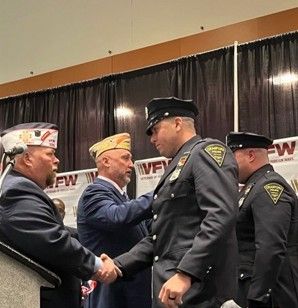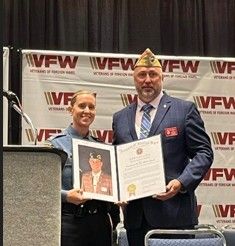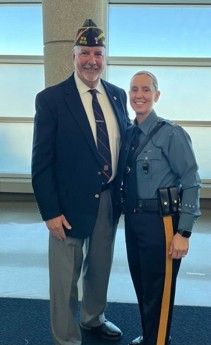Safety and Recognition Program
SERVING AMERICA’S COMMUNITIES
AND
HONORING THEIR PROTECTORS
- Since 1923, the Veterans of Foreign
Wars has concerned itself with the safety of the communities
in which their Posts and members reside.
Alarmed over the post-WWI use of drugs, VFW magazine,
then called Foreign Service, printed a resolution calling for
President Warren G. Harding to declare a National Anti-Dope
Week and set up a national conference to deal with the
problem. VFW Posts began a process of making the public
aware of the dangers of drug use that continues to this day.
Early on, VFW Posts began sponsoring bicycle safety clubs.
- In
1962, Posts started providing reflective stickers through the
Lite-a-Bike program. When manufacturers began putting
lights on bicycles, the reflective stickers were moved to
backpacks and jackets and the program became Lite-a-Tike.
Working with the National Safety Council, driver safety
programs were part of the first safety efforts. Later the VFW
began to promote AARP’s 55 Alive/Mature Driving program.
Throughout the history of the VFW, Posts have been quick to
recognize the contributions of those who make our homes,
highways and communities safer.
- Today, VFW Posts regularly honor citizens who save lives and
those who serve the community as emergency responders. A
special section in this manual is dedicated to the ways in
which these courageous individuals can be recognized at
every level of the VFW.
In the late 1970s, VFW families became increasingly
concerned about the safety of their children. One of the first
organizations to create a child ID kit, the VFW provided
hundreds of thousands of parents with this tool they hoped
would never be used.
With the tragedy of 9/11, the VFW has begun encouraging
Posts to utilize the resources of the Department of Homeland
Security and the Federal Emergency Management Agency
(FEMA). These organizations, as well as hundreds of others,
provide printed materials about safety in the home,
community, while traveling, almost anywhere.
National Citation of Recognition
- Public Servant Award Citations for Emergency Medical
Technicians, Law Enforcement Personnel and Firefighters
- VFW National Emergency Medical Technician Public
Servant Citation
- VFW National Law Enforcement Public Servant Citation
- VFW National Firefighters Public Servant Citation
Criteria for these awards - Candidates must have
demonstrated:
- Recognition by their colleagues or those they serve
- Consistent excellence in the performance of their
duties.
- Consistent dedication to their official responsibilities
over a period of years and continuous growth in
responsibilities and skills within their profession.
- Dispatchers can compete for the awards
Youth Cadet Awards
The VFW awards for special recognition of outstanding
achievement and exceptional leadership are available for
Junior and Senior ROTC programs, Naval Sea Cadets and Civil
Air Patrol Cadets. If any of these programs exist in your
community, these awards provide your Post an outstanding
opportunity to honor these patriotic young people.
CRITERIA FOR CIVIL AIR PATROL AND NAVAL SEA
CADET AWARDS:
- Good academic standing
- Satisfactory progress in the cadet program
- Outstanding achievement in community service and/or
the cadet program
- Outstanding leadership in the cadet program
- High moral character
- Exceptional professionalism in appearance and actions
(Officer Award)
- Outstanding military bearing and conduct in and out
of uniform (NCO Award)
- Involvement in patriotic programs, drill team, color
guard, etc.
- Demonstrated potential and willingness to assume
higher levels of responsibility
Additional criteria for JROTC & SROTC awards:
- Positive attitude toward the ROTC Program
- For JROTC, must be enrolled as a 10th - 12th grade
JROTC student
- For SROTC, must be an undergraduate student enrolled
in Military Science I through IV
- Must maintain a "B” average in ROTC curriculum and a
"C” average in all remaining subjects with no failing
grades in the previous semester
- Active in at least one other student extra-curricular
activity (music, athletics, government, etc.




